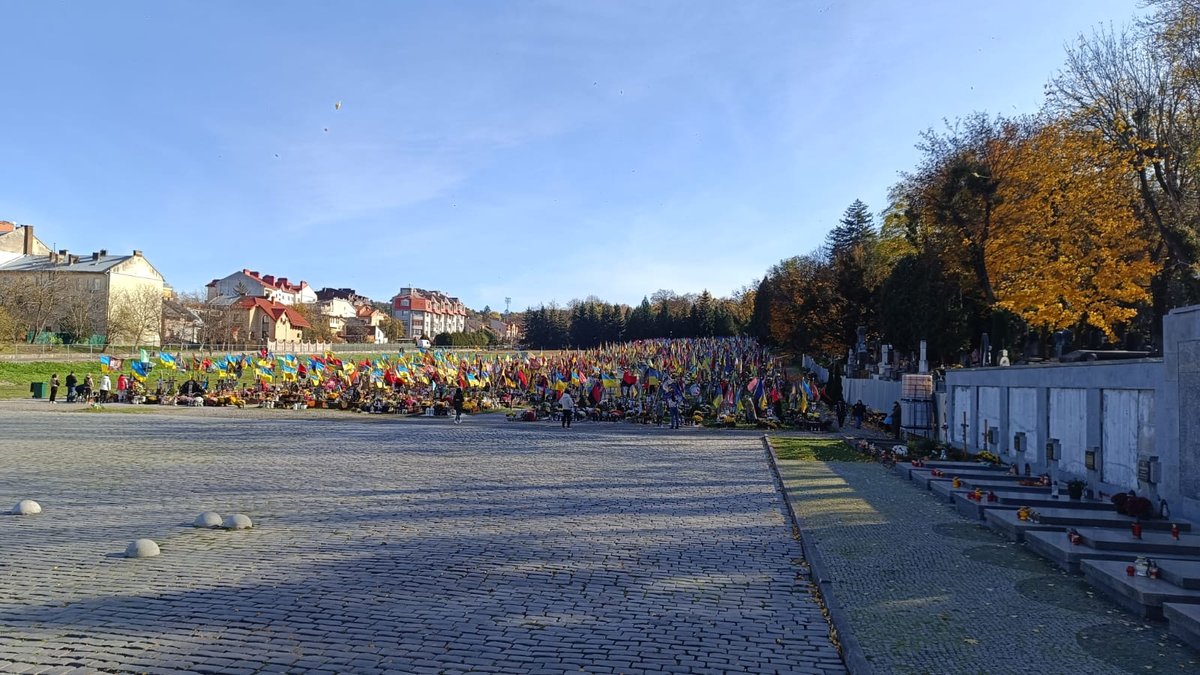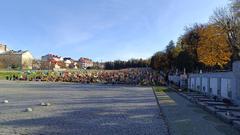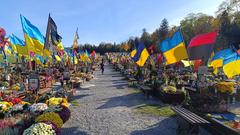
Lychakiv Military Cemetery: Visiting Hours, Tickets, and Historical Guide to Lviv’s Military Heritage
Date: 15/06/2025
Introduction
Lychakiv Military Cemetery, situated in Lviv, Ukraine, is among Eastern Europe’s most significant historical and cultural landmarks. Established in the late 18th century as part of a city-wide effort to move burials outside urban boundaries, Lychakiv evolved into a distinguished necropolis that interlaces art, memory, and history. Its military sections, formally recognized in 1944 and expanded in subsequent decades, pay tribute to a wide array of fallen soldiers: from the young Polish Eaglets and Ukrainian Sich Riflemen to Soviet soldiers of World War II and the defenders lost in ongoing conflicts in Ukraine (visitlviv.net; lviv-lychakiv.com.ua).
With more than 3,000 monuments reflecting neoclassical, art nouveau, and modernist styles, Lychakiv not only serves as a place of remembrance but also as an open-air museum and dynamic cultural institution. Annual commemorations, guided tours, and active restoration efforts engage both locals and international visitors. This comprehensive guide provides essential information for prospective visitors—covering Lychakiv’s historical evolution, military significance, visitor amenities, and nearby Lviv attractions, ensuring an informative and respectful experience (lviv-lychakiv.com.ua; wandrivets.com).
Table of Contents
- Historical Background of Lychakiv Cemetery
- Military Sections and Notable Memorials
- Artistic and Symbolic Features
- Practical Visitor Information (Hours, Tickets, Accessibility)
- Travel Tips and Nearby Attractions
- Preservation and International Cooperation
- Visitor Etiquette
- Frequently Asked Questions (FAQ)
- Summary & Final Tips
- References
1. Historical Background of Lychakiv Cemetery
Founded in 1786, Lychakiv Cemetery was created as part of an effort to relocate burial grounds outside of Lviv’s city limits due to health and urban concerns. Initially, burials here were for marginalized individuals, but over time, the cemetery gained prestige as the clergy and notable citizens chose it as their final resting place (visitlviv.net). The military cemetery within Lychakiv was formally established in 1944 and was later reshaped in the 1970s by architects A. Shuliar and V. Kamenshchyk, and sculptor V. Boyko (lviv-lychakiv.com.ua).
Lychakiv encompasses several interconnected zones, including the Field of Mars, Hill of Glory, and the Cemetery of the Defenders of Lwów, collectively commemorating soldiers from the Polish-Ukrainian War, World War II, and recent Ukrainian conflicts (Wikipedia).
2. Military Sections and Notable Memorials
Polish Eaglets (Orlęta Lwowskie)
This section commemorates the teenage Polish defenders of Lviv during the Polish-Ukrainian War (1918–1920). The area is marked by neoclassical colonnades and restored sculptures, making it a key pilgrimage site for Polish visitors (visitlviv.net).
Ukrainian National Army and Sich Riflemen
Monuments here honor Ukrainian Galician Army members and Sich Riflemen, reflecting Ukraine’s struggle for independence. Annual ceremonies reinforce the cemetery’s continued importance in Ukrainian memory (lviv.travel).
Soviet and World War II Memorials
Soviet-era sections are marked by austere headstones and Soviet symbolism, notably in the Hill of Glory and Field of Mars. These memorials highlight Lviv’s complex, multi-layered history (Pamiec Bliskich).
Recent Burials
The Field of Mars now includes fresh graves for Ukrainian soldiers who perished in current conflicts, especially since 2014. These graves, marked with personal mementos and flags, are sites of ongoing mourning and national reflection (Kyiv Post).
Notable Civilian Burials
Distinguished figures such as poet Ivan Franko, opera singer Solomiya Krushelnytska, and mathematician Stefan Banakh are also interred at Lychakiv, drawing visitors interested in cultural and intellectual history (Wandrivets).
3. Artistic and Symbolic Features
Lychakiv Cemetery is renowned for its artistic heritage, with over 3,000 sculptures and monuments by prominent architects and sculptors like Tadeusz Barącz and Eugenie Dzindra (GuideMe UA). Styles range from gothic and neoclassical to modernist, reflecting Lviv’s multicultural past. The Field of Mars features orderly graves and Soviet memorials, while the Cemetery of the Defenders of Lwów boasts neoclassical gates and a central chapel.
Monuments are inscribed in Ukrainian, Polish, German, and other languages, highlighting the city’s diverse heritage. The cemetery also features thematic memorials to victims of political repression, the Holocaust, and cultural luminaries (Wandrivets).
4. Practical Visitor Information
Location
33 Mechnykova Street, Lviv, Ukraine
Visiting Hours
- April–October: 9:00 AM – 7:00 PM daily
- November–March: 9:00 AM – 5:00 PM daily
- Hours may vary on holidays; check the official website before your visit.
Tickets and Entry Fees
- Adults: 50–100 UAH (varies by section and tour type)
- Students/Children: 25–80 UAH
- Children under 7: Free
- Photography ticket (personal use): 100 UAH; professional photography requires permission (Lychakiv Official Site)
Accessibility
- Main paths are paved and suitable for wheelchair users, but older sections and military areas have uneven terrain. Electric cart tours and assistance are available upon request.
Guided Tours
- Offered in Ukrainian, Polish, English, and Russian.
- Night tours with lanterns provide a unique atmosphere (GuideMe UA).
- Book in advance, especially during peak seasons.
Facilities
- Restrooms near the entrance
- Visitor center with maps and information
- Benches throughout the grounds
- No food vendors inside; cafés nearby
- Parking available but limited
5. Travel Tips and Nearby Attractions
- Best visiting times: Early morning or late afternoon for tranquility and better light for photography.
- Recommended attire: Comfortable shoes due to cobblestone paths and uneven terrain.
- Nearby attractions: Lviv Old Town (UNESCO site), Lviv Opera House, High Castle Park, Lubomirski Palace, Shevchenkivskyi Hay open-air museum. All are easily reachable by public transport or taxi.
6. Preservation and International Cooperation
Since 2008, restoration and conservation projects have been undertaken in partnership with the Lviv City Council and international organizations like the Polish Institute “Polonika.” These efforts include monument restoration, path paving, and landscape management, supported by museum revenues and grants (heritageandmemorystudies.humanities.uva.nl).
Digitization projects, such as those by Find a Grave, are making burial records and biographies accessible worldwide.
7. Visitor Etiquette
Lychakiv Military Cemetery remains an active site of mourning, especially amid ongoing conflicts. Visitors should:
- Maintain quiet and respectful behavior
- Avoid disrupting ceremonies or mourners
- Observe posted rules regarding photography and access
- Refrain from touching monuments or leaving litter
Personal tributes—flowers, candles, and small mementos—are common and respected forms of commemoration (Kyiv Post).
8. Frequently Asked Questions (FAQ)
Q: What are the visiting hours of Lychakiv Military Cemetery?
A: Typically 9:00 AM to 7:00 PM (April–October) and 9:00 AM to 5:00 PM (November–March). Check the official site for updates.
Q: How much are tickets?
A: Entry fees range from 50–100 UAH for adults and 25–80 UAH for students/children. Guided tours and photography require additional fees.
Q: Are guided tours available?
A: Yes, in several languages. Book at the entrance or online.
Q: Is the cemetery accessible for wheelchairs?
A: Main paths are accessible, but some sections are challenging. Contact the visitor center for assistance.
Q: Is photography allowed?
A: Yes, with a photography ticket. Professional shoots require permission.
Q: Are there nearby attractions?
A: Yes. Lviv Old Town, Opera House, and several museums are close by.
9. Summary & Final Tips
Lychakiv Military Cemetery is a profound testament to Lviv’s complex history, blending military valor, artistic heritage, and collective memory. Its meticulously preserved monuments and diverse cultural layers make it a must-visit for anyone interested in Ukraine’s past and present. For a meaningful visit:
- Plan ahead and check visiting hours
- Wear comfortable footwear
- Consider a guided tour for deeper insight
- Respect the solemnity of the site, especially amid ongoing commemorations
Pair your visit with other Lviv attractions for a fuller cultural experience. Enhance your trip with audio guides like the Audiala app and consult official resources for the latest updates.
10. References
- Lychakiv Military Cemetery in Lviv: Visiting Hours, Tickets, and Historical Significance (visitlviv.net)
- Visiting Lychakiv Military Cemetery in Lviv: History, Tickets, Hours, and Travel Tips (lviv-lychakiv.com.ua)
- Lychakiv Cemetery Visiting Hours, Tickets, and Historical Highlights: A Complete Guide (wandrivets.com)
- Lychakiv Military Cemetery Visiting Hours, Tickets, and Guide to Lviv’s Historic Military Site (heritageandmemorystudies.humanities.uva.nl)
- Lychakiv Cemetery Official Site (https://lviv-lychakiv.com.ua/en/)
- A Visit to Lviv’s Cemetery and Its Freshly Dug War Graves (Le Monde)
- Lychakiv Cemetery - History, Tombs of Famous People, Interesting Facts (Hotel Edem)
- Find a Grave: Field of Honorable Burials (Find a Grave)
- GuideMe UA: Tour to Lychakiv Cemetery (GuideMe UA)
- Pamiec Bliskich: Lychakiv Cemetery (Pamiec Bliskich)
- Kyiv Post: Lychakiv Cemetery’s War Graves (Kyiv Post)
For detailed directions, audio guides, and the latest events, visit the official Lychakiv Cemetery website and consider downloading the Audiala app.




































